The iPad Air Review
by Anand Lal Shimpi on October 29, 2013 9:00 PM ESTiPhone to iPad: CPU Changes
Although the iPad Air uses the same A7 from the iPhone 5s (and M7 motion coprocessor), there are a few minor differences that do lead to better performance.
At a high level we’re still talking about two 64-bit Apple Cyclone cores with 128KB L1s (64KB I$ + 64KB D$) per core, a shared 1MB L2 cache and a 4MB L3 cache that services the entire SoC. Apple increased CPU frequency from 1.3GHz to 1.4GHz in the iPad Air, a mild increase but in line with what we’ve seen from previous iPad designs. That’s the first impact on performance - a 7.69% increase in CPU frequency.
The second impact on performance is something I only noticed while digging around under the hood of the A7. It seems like the implementation in the iPad Air can, for whatever reason, hold more instructions in flight (over 20% more) than the A7 in the iPhone 5s. It’s unclear to me whether the A7 in the iPad is configured any differently via firmware/microcode or if perhaps we’re looking at a slightly different revision of the core, but the delta was repeatable in my testing.
The third, and likely biggest change impacting the iPad Air’s implementation of the A7 is the additional thermal headroom afforded by the larger chassis. I’m not going to go into details on exactly what this next test does (unfortunately we’re going to occlude some of the low level work that we do in light of all of the benchmark cheating going on), but we’re looking at a curve of performance vs. time for a particularly power heavy mix of code. We’re running the same exact code on both the iPad Air and iPhone 5s here, the only real difference is the size of the chassis:
You can see the 5s throttles back its CPU frequency to about 1GHz after the 2 minute mark. The crazy thing is that until that point the 5s manages to run at full frequency without so much as a hiccup for two full minutes, running an incredibly power hungry task. Given that most iOS apps aren’t this power intensive for such a sustained period of time, iPhone 5s users should almost always see the A7 running at a full 1.3GHz. Pretty crazy.
The iPad Air by comparison shows much more controlled behavior. Early on in the test we see a 7.7% performance advantage, which lines up perfectly with the iPad Air’s 7.7% CPU frequency advantage. By the end of the test the iPhone 5s has throttled to 900MHz, while the iPad Air drops to around 1.2GHz. At this point the iPad Air’s performance advantage grows to almost 40%.
CPU Performance
I've gone through our standard set of cross-platform browser based benchmarks to place the iPad Air's performance in perspective. As I mentioned in our 5s review, I don't know that there are many (any?) applications on iOS 7 that can really take advantage of all the A7 has to offer. There's definitely a ton of headroom left in the design. What's particularly exciting is when the A7 ends up in n-1 or n-2 iOS devices and it becomes the minimum developer target going forward.
I won't go through all of the results here again, but it's safe to say that the iPad Air is the fastest ARM based tablet on the planet at this point.
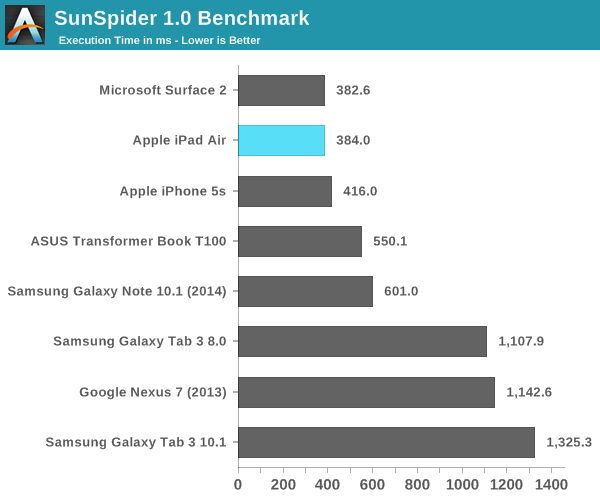
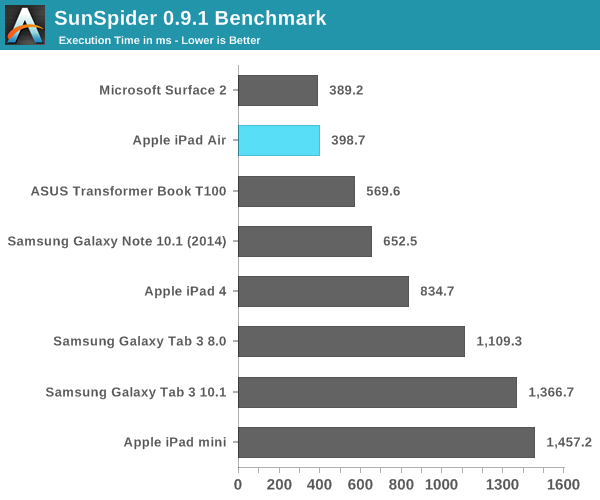
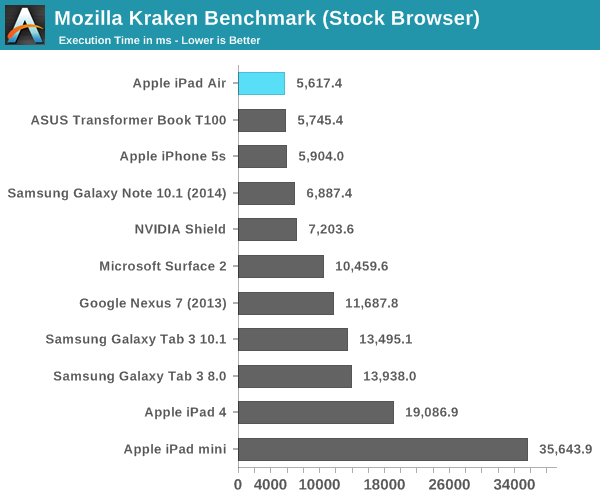
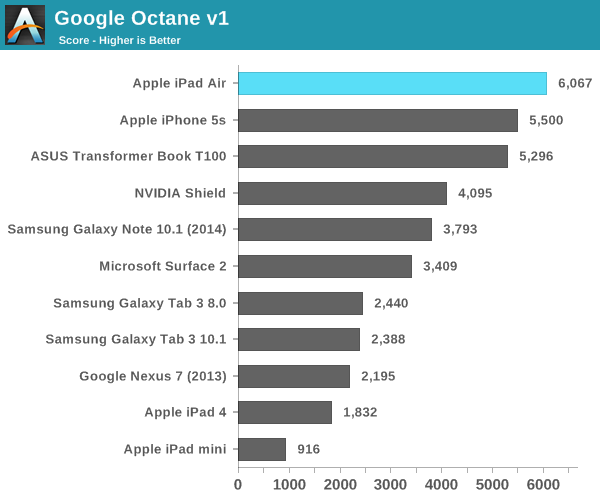
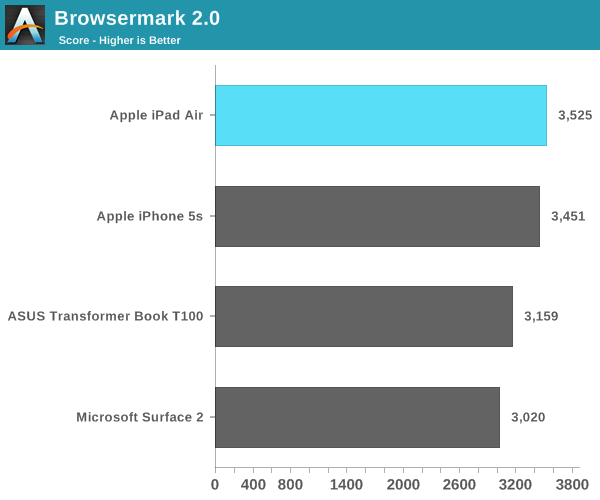

A7 Power Consumption
I’ll get to battery life in a bit, but I’ve been curious about the dynamic range of power consumption offered by Apple’s new A7 SoC. On the one hand we’re dealing with a lower power process (28nm vs. 32nm), but on the other hand Apple’s Cyclone cores can clearly draw more power given how beefy the architecture is this round. Apple frowns upon review sample dissection so I had to turn to a less scientific method of external platform level power measurement. The fidelity of the numbers here aren’t all that great but it’s better than nothing.
For the first test I measured platform power consumption during a Kraken run:
I purposely started measuring before the benchmark so I could get an idea of idle power consumption. The iPad Air consumes roughly 72% of the idle power as the iPad 4, both running at the same brightness. Here we’re not just seeing the A7’s advantages but also things like lower display power.
Focusing on the load portion of the measurement we see that both the new iPad and old iPad consume the same total power in this test. I suspect the A7 is drawing more power than the A6X, but it’s masked by a lower power display. Given how much faster the iPad Air is, Apple’s latest tablet features far lower overall task energy than the outgoing iPad 4. This is probably both the best case scenario for the iPad Air and the most likely case as well.
For kicks I wanted to see just how much power I could get the iPad Air to draw. Here I’m looking at platform power during our mini-power-virus test from above:
How’s that for dynamic range? Almost 12W running all out, but around half that in what we’d normally consider to be a stressful CPU test. I couldn’t get any actual applications/games on the iPad Air to behave like this so the results above are purely academic (for now). A quick run through GFXBench 2.7’s T-Rex HD test confirms that even pushing the GPU won’t hit these numbers. The max I saw running T-Rex offscreen was ~6W, and turning to an actual game (Infinity Blade 3) the iPad Air pulls less than 5W.


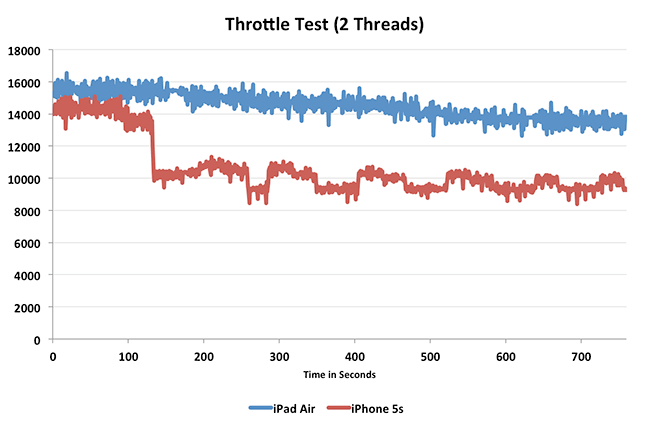
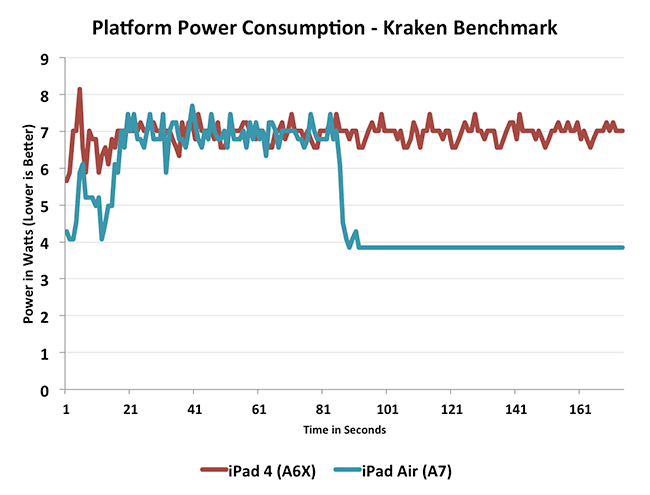
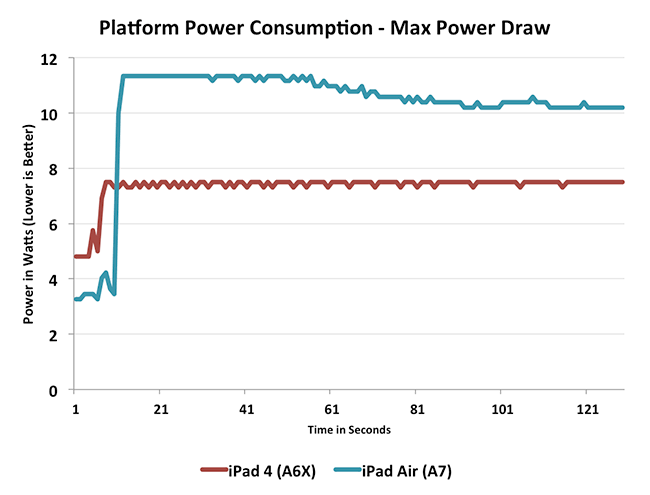








444 Comments
View All Comments
tipoo - Tuesday, October 29, 2013 - link
Agreed, a sub-name only makes sense if a second product is coming out. 12" iPad Platform based system in a MBA form factor, mayhaps?User.Name - Tuesday, October 29, 2013 - link
This device, like so many recent Apple product announcements, is both very exciting, and very disappointing at the same time.Dropping 1/3 of the weight from the iPad and making the device smaller while keeping the same display size is a huge improvement over the old hardware.
But there are so many things I have wanted Apple to address, that they have not.
1. The display is not bonded to the glass. My television from 2010 has this, so does my notebook, my phone, and Microsoft manage it with the Surface. This needs to change.
2. Even though moving to 64-bit requires more memory, they stuck with 1GB of RAM. I was already constantly running into a lack of RAM on my iPad 3.
3. It still starts at 16GB. 16GB on my iPad 2 was tight, and it got worse once apps started coming with retina assets. With no external expansion, 16GB seems awfully tight now.
4. There's no A7X. Yes, the A7 may be a fast chip, and there are less thermal restrictions inside the iPad than the iPhone, but the demands of the iPad are significantly higher. I suppose with them making the device a lot smaller, this is the compromise they thought best, but it's still disappointing.
I sold my iPad six weeks ago in preparation of the new tablet devices, fully intending on replacing it with a Surface Pro 2, but after seeing that they just stuck with the old display rather than improving its color accuracy (all they did was load an ICC profile) and the disappointing battery life, I decided against it.
Being without the iPad for six weeks though, has made me reconsider whether I want one. It was originally my fallback plan if the Surface didn't work out, but now I'm unsure that I want another. The main reason I was moving away from it to begin with was due to the software restrictions, and annoyances such as the screen reflections and lack of RAM, which have not been addressed at all with this update.
I'm having a very difficult time trying to find something which meets my requirements.
dugbug - Wednesday, October 30, 2013 - link
"4. There's no A7X. Yes, the A7 may be a fast chip, and there are less thermal restrictions inside the iPad than the iPhone, but the demands of the iPad are significantly higher. I suppose with them making the device a lot smaller, this is the compromise they thought best, but it's still disappointing."Why? Why do you need an A7X and why is that disappointing?
User.Name - Wednesday, October 30, 2013 - link
In some of the tests, it seems to be performing worse than the iPad 4.In many of the tests, performance is lower than that of the iPhone 5s - by as much as 50% in some tests.
I expect better performance from a large tablet device than I do from something which fits in my pocket.
It means that if a developer does a "simple" port from one device to the other, the iPad version is going to perform worse than the same thing running on an iPhone. I think that's very disappointing, and it's the reason the A5X and A6X existed.
errorr - Wednesday, October 30, 2013 - link
I don't think there are any apps out there that can stress the A7. I see it more that Apple chose ro put a throttled tablet SOC into a phone. It has way too much power for the 5s screen and will bottleneck elsewhere first.dugbug - Thursday, October 31, 2013 - link
The A7 has a lot of headroom, way overkill for the phone. seriously, this is such an edge concern.Kvaern - Wednesday, October 30, 2013 - link
I don't quite get the fuss about the 16gb baseline.I mean if it isn't enough for you then get a larger model but why would you want to force 32gb on people who needs no more than 16gb?
User.Name - Wednesday, October 30, 2013 - link
Apple seem to operate largely by keeping their prices fixed, and introducing better hardware at the same price point. 16GB is not a lot of storage now, considering what Apple is charging, and when there is no option to expand that.As I said in my previous post, I originally purchased a 16GB iPad 2, without knowing how restrictive that would be - you get less than 16GB usable space, and what you may not realize is that you also have to keep 1-2GB free to be able to update apps. (or at least you did at the time; iOS 7 may have changed this?)
Once apps started adding retina assets, many of them increased 2-3x in size, further reducing the number of apps you could keep on the device, even though the iPad 2 itself had no use for those assets.
I think the base spec being 16GB really hurts the user experience. I constantly found myself having to remove apps from the device, and couldn't really store any media on the device itself. (even podcasts had to be restricted)
I then went with a 64GB iPad 3 the next year, and now I would probably recommend that most people buy the 32GB model. I know too many people that bought a 16GB iPad, only to find themselves replacing the device the next year, not because they wanted a faster device, but because it didn't have enough storage for all the apps they wanted to run. (games and educational apps seem to be the worst offenders)
I'm sure there are some people whose usage is fine with 16GB, but when Apple are charging a premium price, I just don't think 16GB is enough.
It's a similar situation to the RAM in the device. 64-bit now requires more memory than previous generations of the iPad, but they stuck with 1GB of RAM, making the user experience worse than it was before.
akdj - Wednesday, October 30, 2013 - link
"64-bit now requires more memory than previous generations of the iPad, but they stuck with 1GB of RAM, making the user experience worse than it was before."Hmmm....I read the whole article, didn't notice that mentioned at ALL! Seemingly, overall...Anand's experience with the 'Air' was significantly 'better' than ANY other tablet he's reviewed/used.
As far as NAND/Storage size....this is ubiquitous throughout the industry. Most OEMs are shipping 16GB models as their 'entry' level device. For folks not interested in downloading games or 'big' apps (My mom loves her iPad 2 16GB and has never run out of space)---that amount is just fine. No other tablets are shipping with 128GB currently, right? You've got choice. Use it. Use your head. Now that you know 16GB isn't enough for you....and 64 is too much, you've finally figured out you need 32GB. Good for you....as I'd also like to see Apple start off with a 32GB iOS device as the minimum, they're not aiming the 16GB model at power users...they offer 4 different sizes with your choice of WiFi or LTE. Same thing, gotta make that choice. I'd love every model to include LTE. It doesn't. You HAVE to make a choice that benefits YOU.
Everyone uses their tablets differently. With cloud storage (Dropbox, iCloud, Box, Google Drive, et al.), one has the option to store their information outside of the tablet and access it when necessary. Many folks don't game. You can now stream from iTunes Match...no need to d/l the entire movie first. That said...if you want more storage, BUY more storage! Apple is in parity with the rest of the entry level OEMs....16GB is pretty standard, other than some that are still releasing 8GB models (first Nex7?)....or models with only options of 16 or 32GB on board.
J
User.Name - Wednesday, October 30, 2013 - link
Yes, but other devices shipping with 16GB storage are significantly cheaper, and/or have expandable storage options. (plug in a 64GB SDXC Micro card)And to move from 64GB to 128GB (+64GB) costs $100 - the same as moving from 16GB to 32GB. (+16GB)
I'm quite sure they could offer a 32GB at the current price.
As for 1GB RAM affecting the user experience, I suppose it depends how you use the device.
I was constantly running out of RAM on my iPad 3, which also had 1GB - and that is effectively more than the Air has.